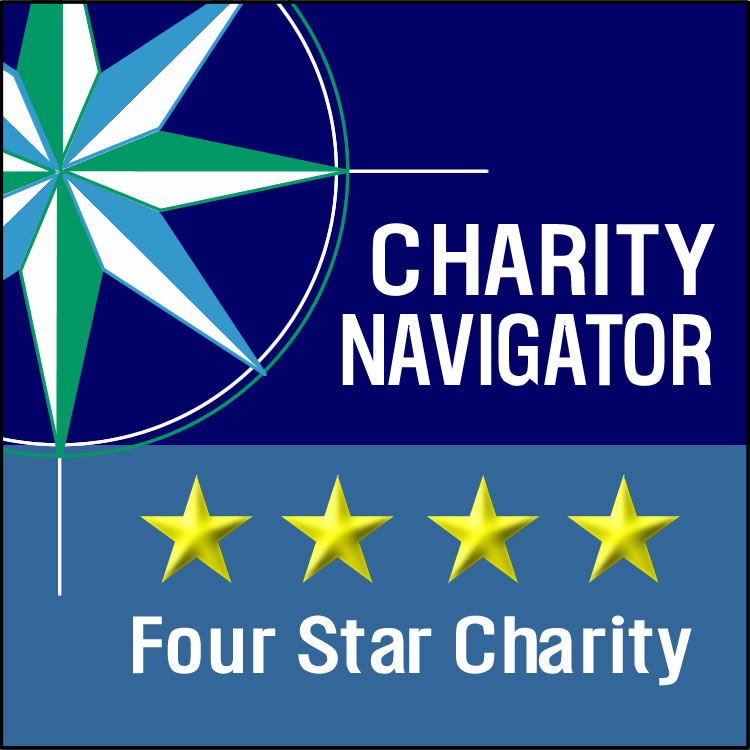March is Workplace Eye Wellness Month
 Prevent Blindness – the oldest eye health and safety non-profit in America – designates March as Workplace Eye Wellness Month. In 2021, the organization would like to focus on digital eye strain.
Prevent Blindness – the oldest eye health and safety non-profit in America – designates March as Workplace Eye Wellness Month. In 2021, the organization would like to focus on digital eye strain.Amid a global pandemic, most Americans use their digital devices – smartphones, tablets, and computers – more frequently and for longer durations. Symptoms of digital eye strain include burning eyes, itching eyes, dry eyes, blurred vision, and headache.
Prevent Blindness has launched the Screen Time-Out awareness campaign. The initiative encourages us to schedule regular breaks throughout the day from our devices.
Please contact SDCB to learn more about our vision rehabilitation programs and services.
“Prevent Blindness Declares March as Workplace Eye Wellness Month”

 One of the hallmarks of glaucoma is elevated levels of intraocular pressure (IOP) in the eye. It would be useful to have a non-invasive method of checking a person’s IOP and could lead to early detection of glaucoma, which could prevent blindness down the road. A group of researchers suggests that using smartphones to scan our eyes could help detect eye diseases. Using soundwaves generated for our smartphones could prevent glaucoma blindness. Dr. Khamis Essa, Director of the Advanced Manufacturing Group at the University of Birmingham, says:
One of the hallmarks of glaucoma is elevated levels of intraocular pressure (IOP) in the eye. It would be useful to have a non-invasive method of checking a person’s IOP and could lead to early detection of glaucoma, which could prevent blindness down the road. A group of researchers suggests that using smartphones to scan our eyes could help detect eye diseases. Using soundwaves generated for our smartphones could prevent glaucoma blindness. Dr. Khamis Essa, Director of the Advanced Manufacturing Group at the University of Birmingham, says: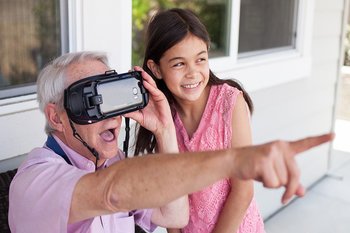 Millions of Americans are affected by macular degeneration, glaucoma, retinitis pigmentosa and diabetes-related eye diseases. These conditions can lead to low vision and blindness. Those living with blinding eye diseases can experience loss of independence, and often have to rely on others for support. However, scientific advancements have led to the development of new technology for low vision and blindness. Some of those include OrCam MyEye Pro, WeWALK, eSIght, and IrisVision.
Millions of Americans are affected by macular degeneration, glaucoma, retinitis pigmentosa and diabetes-related eye diseases. These conditions can lead to low vision and blindness. Those living with blinding eye diseases can experience loss of independence, and often have to rely on others for support. However, scientific advancements have led to the development of new technology for low vision and blindness. Some of those include OrCam MyEye Pro, WeWALK, eSIght, and IrisVision. “Eyes on Capitol Hill,” an annual advocacy event, brings patients, caregivers, public health workers and medical professionals with their elected officials. The goal is to educate lawmakers about eye diseases that cause vision loss and blindness. The Prevent Blindness Eyes on Capitol Hill event will be held virtually this year, on Wednesday, Feb. 24, and Thursday, Feb. 25.
“Eyes on Capitol Hill,” an annual advocacy event, brings patients, caregivers, public health workers and medical professionals with their elected officials. The goal is to educate lawmakers about eye diseases that cause vision loss and blindness. The Prevent Blindness Eyes on Capitol Hill event will be held virtually this year, on Wednesday, Feb. 24, and Thursday, Feb. 25.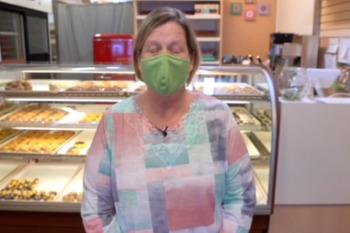 Some 11 million Americans are losing their vision due to macular degeneration. Unfortunately, the leading cause of blindness has no approved treatment options. However, thanks to new advancements in science, doctors are now treating blindness with cell transplant therapy.
Some 11 million Americans are losing their vision due to macular degeneration. Unfortunately, the leading cause of blindness has no approved treatment options. However, thanks to new advancements in science, doctors are now treating blindness with cell transplant therapy.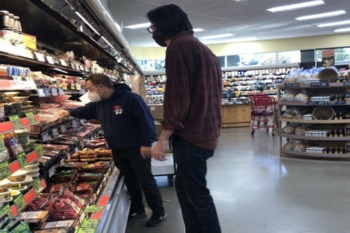 All of our lives have been affected by the COVID-19 pandemic. However, it is safe to say that those impacted the most are people living with vision loss or other disabilities. Simply put, COVID-19 makes life harder for the visually impaired. The pandemic has forced sighted people to lend their hand to the visually impaired due to contraction fears. How do you know if you are six feet away from someone when you are blind?
All of our lives have been affected by the COVID-19 pandemic. However, it is safe to say that those impacted the most are people living with vision loss or other disabilities. Simply put, COVID-19 makes life harder for the visually impaired. The pandemic has forced sighted people to lend their hand to the visually impaired due to contraction fears. How do you know if you are six feet away from someone when you are blind? Most Americans have seen people with white canes crossing the street. Some individuals have likely thought about the inherent dangers associated with blind people navigating intersections. While many crosswalks have what are known as Accessible Pedestrian Signals (APS) — beeps and chirps let people know when to cross — to assist people with visual impairments to understand when it is safe to cross the street, it can still be dangerous.
Most Americans have seen people with white canes crossing the street. Some individuals have likely thought about the inherent dangers associated with blind people navigating intersections. While many crosswalks have what are known as Accessible Pedestrian Signals (APS) — beeps and chirps let people know when to cross — to assist people with visual impairments to understand when it is safe to cross the street, it can still be dangerous.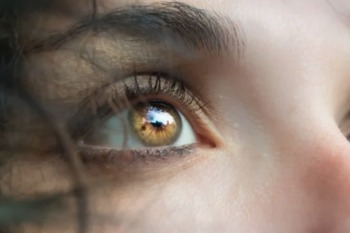 The World Health Organization (WHO) estimates that more than 90 percent of the global population lives in places where air quality levels exceed the limits set for pollutants that pose health complications.
The World Health Organization (WHO) estimates that more than 90 percent of the global population lives in places where air quality levels exceed the limits set for pollutants that pose health complications. Millions of Americans are living with vision loss and blindness. While losing one's vision can be a devastating blow, it does not mean you have to give up on your dreams. Even though Wayne Schwartz is blind, he does not let blindness prevent him from fulfilling his dream of operating a coffee house. He and his wife converted a vacant pizza parlor into a coffee shop. Never let blindness get you down is a maxim Schwartz lives by today.
Millions of Americans are living with vision loss and blindness. While losing one's vision can be a devastating blow, it does not mean you have to give up on your dreams. Even though Wayne Schwartz is blind, he does not let blindness prevent him from fulfilling his dream of operating a coffee house. He and his wife converted a vacant pizza parlor into a coffee shop. Never let blindness get you down is a maxim Schwartz lives by today.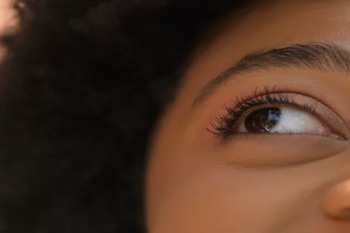 Did you know that some 32.2 million adults in the United States have experienced some form of vision loss? It is vital to have regular eye exams to prevent losing your sight. What's more, it's helpful to know some of the most common causes of vision loss and what you can expect should you become afflicted. If you experience any vision changes, please make an appointment to see an eye doctor; being proactive can prevent vision loss.
Did you know that some 32.2 million adults in the United States have experienced some form of vision loss? It is vital to have regular eye exams to prevent losing your sight. What's more, it's helpful to know some of the most common causes of vision loss and what you can expect should you become afflicted. If you experience any vision changes, please make an appointment to see an eye doctor; being proactive can prevent vision loss.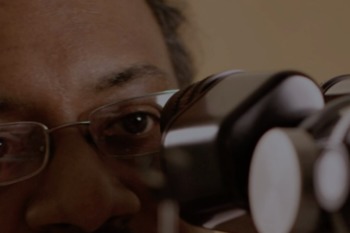 While Macular degeneration is the number one cause of vision loss among older Americans, there are currently no FDA-approved medications to treat the condition. Ten million Americans are living with macular degeneration. Jayakrishna Ambati, a University of Virginia professor of ophthalmology, has discovered that HIV drugs may prevent vision loss.
While Macular degeneration is the number one cause of vision loss among older Americans, there are currently no FDA-approved medications to treat the condition. Ten million Americans are living with macular degeneration. Jayakrishna Ambati, a University of Virginia professor of ophthalmology, has discovered that HIV drugs may prevent vision loss. Here are 25 of the best apps for the blind and visually impaired, updated for 2021.
Here are 25 of the best apps for the blind and visually impaired, updated for 2021. Age-related macular degeneration is one of the leading causes of irreversible blindness in older adults, and a new long-term study just revealed that air pollution could be linked to a heightened risk of AMD. If these findings are confirmed, they could pave the way for new treatment options.
Age-related macular degeneration is one of the leading causes of irreversible blindness in older adults, and a new long-term study just revealed that air pollution could be linked to a heightened risk of AMD. If these findings are confirmed, they could pave the way for new treatment options. There is no way of knowing how one would respond to losing vision, either temporarily or permanently. In either case, it is sure to be a frightening experience. However, some people take the hand they're dealt and dive headfirst into their passion. Singer, songwriter Brooke Moriber's sudden, temporary vision loss became a catalyst for music. She explains that her eye disease and subsequent treatments gave her a better understanding of who she was as an artist and what she wanted her music to be.
There is no way of knowing how one would respond to losing vision, either temporarily or permanently. In either case, it is sure to be a frightening experience. However, some people take the hand they're dealt and dive headfirst into their passion. Singer, songwriter Brooke Moriber's sudden, temporary vision loss became a catalyst for music. She explains that her eye disease and subsequent treatments gave her a better understanding of who she was as an artist and what she wanted her music to be.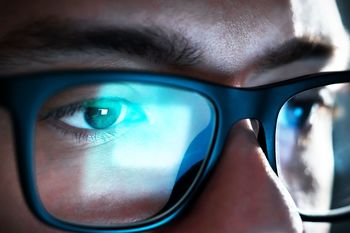 The global pandemic has changed our lives in many ways. We are all familiar with social distancing and spending copious amounts of time confined to our homes and apartments. In isolation, countless individuals spend more time than ever on their computers, tablets, and smartphones. Could it be that the COVID-19 pandemic causes vision loss in some people? What are the consequences of more than a year of increased screentime?
The global pandemic has changed our lives in many ways. We are all familiar with social distancing and spending copious amounts of time confined to our homes and apartments. In isolation, countless individuals spend more time than ever on their computers, tablets, and smartphones. Could it be that the COVID-19 pandemic causes vision loss in some people? What are the consequences of more than a year of increased screentime?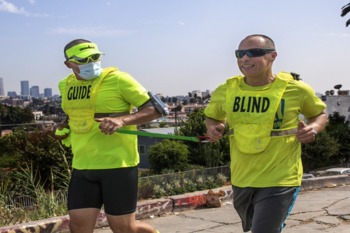 53-year-old Tony Duenas lost his sight due to sudden retinal detachment in 2009. The event left Duenas living with total blindness. Fortunately, he does not let total vision loss hold him back in life. In fact, he became an avid runner. Today he engages in running marathons with blindness thanks to the help of a "guide runner." His passion doesn't stop at marathons; Duenas also competes in triathlons.
53-year-old Tony Duenas lost his sight due to sudden retinal detachment in 2009. The event left Duenas living with total blindness. Fortunately, he does not let total vision loss hold him back in life. In fact, he became an avid runner. Today he engages in running marathons with blindness thanks to the help of a "guide runner." His passion doesn't stop at marathons; Duenas also competes in triathlons.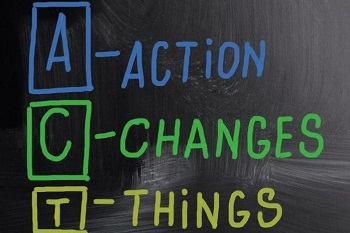 All children face the challenge of learning everyday skills – such as dressing and undressing, personal hygiene, cooking, eating, and simply getting around – but kids with blindness or visual impairment face added obstacles, which can be overcome. They arguably have a bit of an advantage over visually impaired adults who may be relearning how to do things they knew how to do when fully sighted – since these kids are learning these things for the first time, rather than having to relearn them and possibly alter long-entrenched habits.
All children face the challenge of learning everyday skills – such as dressing and undressing, personal hygiene, cooking, eating, and simply getting around – but kids with blindness or visual impairment face added obstacles, which can be overcome. They arguably have a bit of an advantage over visually impaired adults who may be relearning how to do things they knew how to do when fully sighted – since these kids are learning these things for the first time, rather than having to relearn them and possibly alter long-entrenched habits. Just because you can’t see the same way as most other people doesn’t mean you can’t lead an independent, fulfilling life. Luckily, there are a number of things you can do, and technology can help, to create and maintain your independence. For example, make sure you enlarge anything you want to see. Learn to make the most efficient use of the eyesight you have. Reduce glare. Use your ears instead of your eyes.
Just because you can’t see the same way as most other people doesn’t mean you can’t lead an independent, fulfilling life. Luckily, there are a number of things you can do, and technology can help, to create and maintain your independence. For example, make sure you enlarge anything you want to see. Learn to make the most efficient use of the eyesight you have. Reduce glare. Use your ears instead of your eyes. Christina Swider, better known as Xtina Louise, is using her music platform to raise money for young people with blindness and low vision. The recent Butler University grad worked with children who are blind and visually impaired while attending college. Now, she is joining forces with Visually Impaired Preschool Services (VIPS Indiana). Hopefully, her music will raise a lot of money for the organization.
Christina Swider, better known as Xtina Louise, is using her music platform to raise money for young people with blindness and low vision. The recent Butler University grad worked with children who are blind and visually impaired while attending college. Now, she is joining forces with Visually Impaired Preschool Services (VIPS Indiana). Hopefully, her music will raise a lot of money for the organization. The Department of Special Education at Illinois State announced that it will offer a new online master’s program in low vision and blindness. The online program will provide licensed teachers an opportunity to add an endorsement in low vision and blindness while they work to obtain a master’s degree. The program came about because there is a serious shortage in low vision and blindness educators.
The Department of Special Education at Illinois State announced that it will offer a new online master’s program in low vision and blindness. The online program will provide licensed teachers an opportunity to add an endorsement in low vision and blindness while they work to obtain a master’s degree. The program came about because there is a serious shortage in low vision and blindness educators.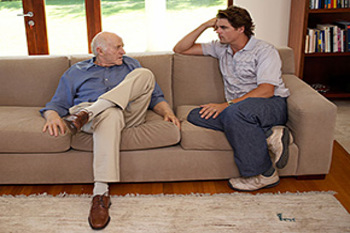 January is National Glaucoma Awareness Month. Right now, over 3 million Americans and more than 60 million people worldwide have glaucoma. However, the number of people impacted by glaucoma is projected to climb to 4.2 million by 2030. The condition is the leading cause of irreversible blindness. Since many people don’t realize they are losing their vision, glaucoma is referred to as the "sneak thief of sight."
January is National Glaucoma Awareness Month. Right now, over 3 million Americans and more than 60 million people worldwide have glaucoma. However, the number of people impacted by glaucoma is projected to climb to 4.2 million by 2030. The condition is the leading cause of irreversible blindness. Since many people don’t realize they are losing their vision, glaucoma is referred to as the "sneak thief of sight."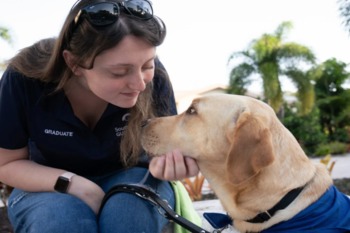 McKenzie Hanlon is 22 years old and has struggled through more than most will endure in a lifetime. Hanlon has suffered a brain aneurism, two nearly-fatal strokes, mobility loss, and vision loss. Thanks to her guide dog CJ, Hanlon can overcome any challenges she faces. CJ assists Hanlon in traversing the world while maintaining her independence from vision loss. Her companionship with CJ inspires her to help others with similar hardships.
McKenzie Hanlon is 22 years old and has struggled through more than most will endure in a lifetime. Hanlon has suffered a brain aneurism, two nearly-fatal strokes, mobility loss, and vision loss. Thanks to her guide dog CJ, Hanlon can overcome any challenges she faces. CJ assists Hanlon in traversing the world while maintaining her independence from vision loss. Her companionship with CJ inspires her to help others with similar hardships.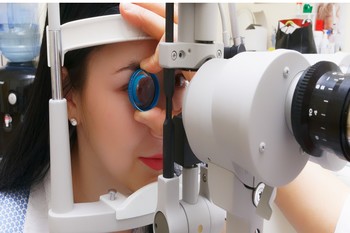 Dr. Pippa Anderson and Dr. Mari Jones, of Swansea University's Centre for Health Economics (SCHE), were awarded a substantial Research for Patient and Public Benefit (RfPPB) grant from Health and Care Research Wales (HCRW). The team is studying how better to manage chronic vision loss conditions in a community setting.
Dr. Pippa Anderson and Dr. Mari Jones, of Swansea University's Centre for Health Economics (SCHE), were awarded a substantial Research for Patient and Public Benefit (RfPPB) grant from Health and Care Research Wales (HCRW). The team is studying how better to manage chronic vision loss conditions in a community setting.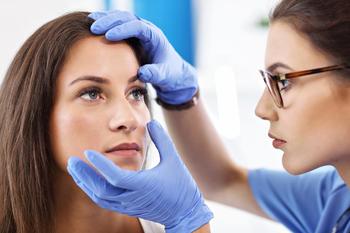 RetinaRisk is an app that helps people determine their risk of blindness from diabetes. Diabetic retinopathy is a form of vision loss that affects over 120 million diabetics worldwide. RetinaRisk was created by healthcare entrepreneur and doctor Arna Gudmundsdottir and her team. The company, which is based in Iceland, has raised $1.8 million; the app has been downloaded by more than 800,000 people worldwide.
RetinaRisk is an app that helps people determine their risk of blindness from diabetes. Diabetic retinopathy is a form of vision loss that affects over 120 million diabetics worldwide. RetinaRisk was created by healthcare entrepreneur and doctor Arna Gudmundsdottir and her team. The company, which is based in Iceland, has raised $1.8 million; the app has been downloaded by more than 800,000 people worldwide.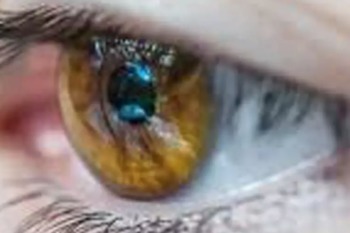 2020 was an exceedingly challenging year, but the New Year is upon us. Now is good time to look back on the previous 365 days and consider the advancements in ophthalmology 2020. Despite COVID-19, advancements in the field of medicine, technology, and science continued to occur. Interestingly, research on the coronavirus led to a better understanding of preventing irreversible vision loss.
2020 was an exceedingly challenging year, but the New Year is upon us. Now is good time to look back on the previous 365 days and consider the advancements in ophthalmology 2020. Despite COVID-19, advancements in the field of medicine, technology, and science continued to occur. Interestingly, research on the coronavirus led to a better understanding of preventing irreversible vision loss.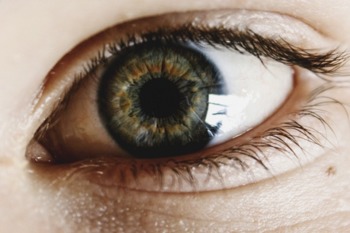 Vision loss and blindness can occur suddenly or gradually over time. The Centers for Disease Control and Prevention estimate that 12 million people age 40 or older in the United States are visually impaired; over 1 million people are blind. It can be helpful to understand the symptoms of vision loss and blindness. By 2050, experts estimate that the number could double.
Vision loss and blindness can occur suddenly or gradually over time. The Centers for Disease Control and Prevention estimate that 12 million people age 40 or older in the United States are visually impaired; over 1 million people are blind. It can be helpful to understand the symptoms of vision loss and blindness. By 2050, experts estimate that the number could double.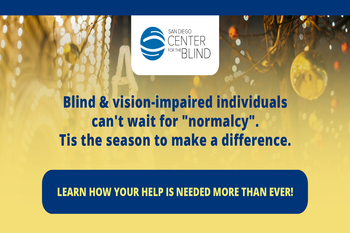 At San Diego Center for the Blind, we are adapting our services for those who depend on us and cannot wait for normalcy. COVID-19 has disrupted our lives and we need your help now more than ever. Right now, it’s critical we support the blind and visually impaired. Please visit our
At San Diego Center for the Blind, we are adapting our services for those who depend on us and cannot wait for normalcy. COVID-19 has disrupted our lives and we need your help now more than ever. Right now, it’s critical we support the blind and visually impaired. Please visit our  With the coronavirus pandemic causing financial hardships for many individuals and families, you may benefit from one of SDG&E’s assistance programs. You can apply online for these bill discount programs. Many people who previously couldn’t take advantage of these income-based programs may now qualify due to lost wages – even if they’re receiving unemployment benefits. These programs include:
With the coronavirus pandemic causing financial hardships for many individuals and families, you may benefit from one of SDG&E’s assistance programs. You can apply online for these bill discount programs. Many people who previously couldn’t take advantage of these income-based programs may now qualify due to lost wages – even if they’re receiving unemployment benefits. These programs include:  Many of us are spending more time at home so we’re probably using more energy. Here are some no-cost and low-cost energy-saving tips. We know that every little bit helps, especially now.
Many of us are spending more time at home so we’re probably using more energy. Here are some no-cost and low-cost energy-saving tips. We know that every little bit helps, especially now. People love lighting up their homes for the holidays – whether it’s inside your home along the fireplace or on your front lawn decorating your trees and bushes. What most people don’t love is the increase in their electricity bill after all the holiday cheer and lights are gone.
People love lighting up their homes for the holidays – whether it’s inside your home along the fireplace or on your front lawn decorating your trees and bushes. What most people don’t love is the increase in their electricity bill after all the holiday cheer and lights are gone. 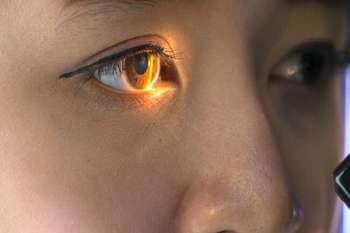 A study conducted on 37 patients with Leber hereditary optic neuropathy (LHON) produced some surprising conclusions. A revolutionary gene therapy showed promise on both eyes, even when only one eye was treated. The researchers found that 78 percent of participants had improved vision in both eyes. The gene therapy restores vision in legally blind patients. LHON affects around 1 in every 50,000 people, and the condition can steal one’s vision rapidly.
A study conducted on 37 patients with Leber hereditary optic neuropathy (LHON) produced some surprising conclusions. A revolutionary gene therapy showed promise on both eyes, even when only one eye was treated. The researchers found that 78 percent of participants had improved vision in both eyes. The gene therapy restores vision in legally blind patients. LHON affects around 1 in every 50,000 people, and the condition can steal one’s vision rapidly.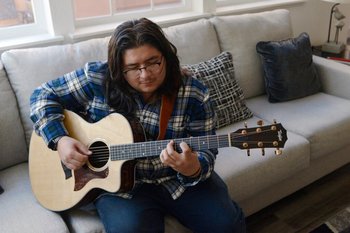 Robert Lucky, 25, became legally blind when he was 14. Nevertheless, he decided to live life to its fullest despite vision loss. He lives independently and has a job; he taught himself how to play the guitar and is even in a band. Even though he is legally blind, he has devised a way to ride an electric scooter. His rare genetic condition slows him down but does not hold him back in life.
Robert Lucky, 25, became legally blind when he was 14. Nevertheless, he decided to live life to its fullest despite vision loss. He lives independently and has a job; he taught himself how to play the guitar and is even in a band. Even though he is legally blind, he has devised a way to ride an electric scooter. His rare genetic condition slows him down but does not hold him back in life.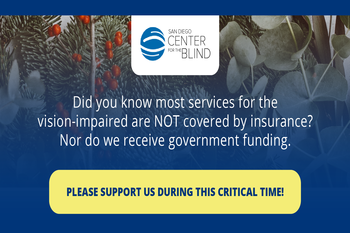 The COVID-19 pandemic has impacted the lives of tens of millions of Americans, especially those living with vision loss and blindness. We ask that you help SDCB help others in 2021 by donating. With your support, we can provide vision rehabilitation services to those most in need in our COVID-19 world.
The COVID-19 pandemic has impacted the lives of tens of millions of Americans, especially those living with vision loss and blindness. We ask that you help SDCB help others in 2021 by donating. With your support, we can provide vision rehabilitation services to those most in need in our COVID-19 world.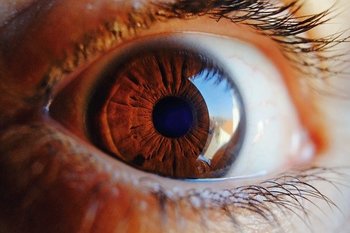 In 2010, the World Health Organization (WHO) set a goal to reduce preventable vision loss by 25 percent by 2020. However, two studies appearing in The Lancet Global Health examining blindness and vision loss rates worldwide found no significant reduction in the number of people with treatable vision loss.
In 2010, the World Health Organization (WHO) set a goal to reduce preventable vision loss by 25 percent by 2020. However, two studies appearing in The Lancet Global Health examining blindness and vision loss rates worldwide found no significant reduction in the number of people with treatable vision loss.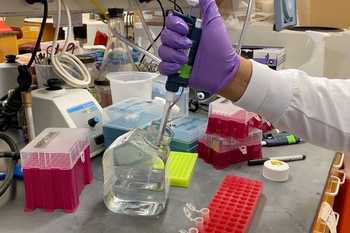 At Harvard University, researchers reversed vision loss in mice that have a condition mimicking human glaucoma. Instead of stemming the progression, the scientists successfully inverted glaucoma-induced vision loss. The findings could lead to the development of new therapies and treatments for reversing aging and age-related diseases in humans.
At Harvard University, researchers reversed vision loss in mice that have a condition mimicking human glaucoma. Instead of stemming the progression, the scientists successfully inverted glaucoma-induced vision loss. The findings could lead to the development of new therapies and treatments for reversing aging and age-related diseases in humans.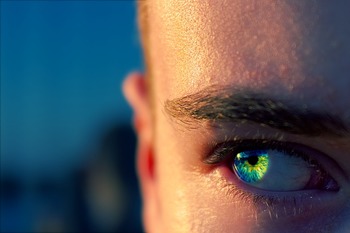 COVID-19 has disrupted the lives of tens of millions of Americans. We have adapted our services to continue helping people living with vision loss and blindness. SDCB needs your help more than ever to assist as many people as possible during these challenging times.
COVID-19 has disrupted the lives of tens of millions of Americans. We have adapted our services to continue helping people living with vision loss and blindness. SDCB needs your help more than ever to assist as many people as possible during these challenging times. Despite vision loss, Zamarian Griffin loves to draw. Griffin has albinism, which affects his vision. He says whatever he draws is his vision. His talent has not gone unnoticed; it helped the visually impaired artist win a graphic design competition. Griffin's work showcased various aspects of visual impairment.
Despite vision loss, Zamarian Griffin loves to draw. Griffin has albinism, which affects his vision. He says whatever he draws is his vision. His talent has not gone unnoticed; it helped the visually impaired artist win a graphic design competition. Griffin's work showcased various aspects of visual impairment. Many blind and visually impaired individuals take part in the sport of running. However, they often cannot run without support; dogs and human guides help blind runners excel. One instance of this is blind high school freshman Paul Scott and fourth-grader Rebel Hays. The latter helps Scott navigate cross country race courses using a rope. They work together as a team; Scott says that his guide inspires him to run faster.
Many blind and visually impaired individuals take part in the sport of running. However, they often cannot run without support; dogs and human guides help blind runners excel. One instance of this is blind high school freshman Paul Scott and fourth-grader Rebel Hays. The latter helps Scott navigate cross country race courses using a rope. They work together as a team; Scott says that his guide inspires him to run faster.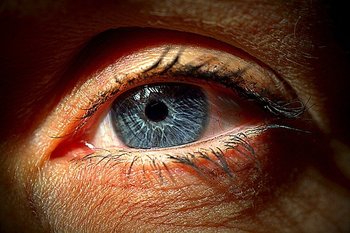 December 1st is
December 1st is 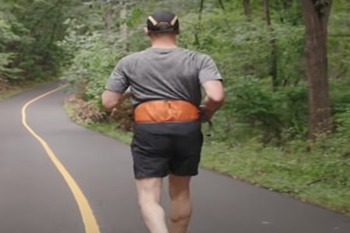 There are millions of people living with vision loss and blindness, but sadly there aren't enough guide dogs available. Guide dogs can help people living with vision loss go running. Fortunately, the new Project Guideline app helps blind people run.
There are millions of people living with vision loss and blindness, but sadly there aren't enough guide dogs available. Guide dogs can help people living with vision loss go running. Fortunately, the new Project Guideline app helps blind people run.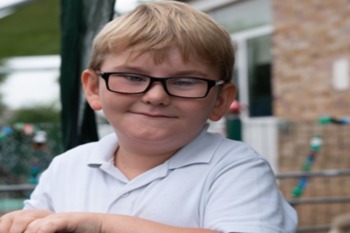 In 2016, Dr. Rachel Pilling – a pediatric ophthalmologist – won Vision UK's Astbury Award for her work within the Bradford Learning Disability Eye Service. Now, the vision loss doctor was appointed with a professorship at the University of Bradford School of Optometry and Vision Science. She is the first professor in special needs and learning disability eye care in the United Kingdom.
In 2016, Dr. Rachel Pilling – a pediatric ophthalmologist – won Vision UK's Astbury Award for her work within the Bradford Learning Disability Eye Service. Now, the vision loss doctor was appointed with a professorship at the University of Bradford School of Optometry and Vision Science. She is the first professor in special needs and learning disability eye care in the United Kingdom. It's easy to take eyesight and hearing for granted. Sixty-one million Americans live with a disability like vision loss, according to the Centers for Disease Control and Prevention (CDC). However, there are many accessibility tools for people with vision loss, including text to speech, braille, large-print, and alt text.
It's easy to take eyesight and hearing for granted. Sixty-one million Americans live with a disability like vision loss, according to the Centers for Disease Control and Prevention (CDC). However, there are many accessibility tools for people with vision loss, including text to speech, braille, large-print, and alt text.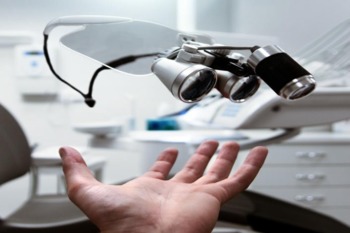 Many people do not understand that diabetes can impact one's eyes. During National Diabetes Awareness Month, we would like to bring your attention to diabetic retinopathy; it's one of the most common forms of diabetic eye disease. It occurs when diabetes affects the retina causing abnormal blood vessels to grow and to bleed. If not treated properly, diabetic retinopathy can cause permanent vision loss. During National Diabetes Awareness Month, you can benefit from scheduling an eye exam.
Many people do not understand that diabetes can impact one's eyes. During National Diabetes Awareness Month, we would like to bring your attention to diabetic retinopathy; it's one of the most common forms of diabetic eye disease. It occurs when diabetes affects the retina causing abnormal blood vessels to grow and to bleed. If not treated properly, diabetic retinopathy can cause permanent vision loss. During National Diabetes Awareness Month, you can benefit from scheduling an eye exam.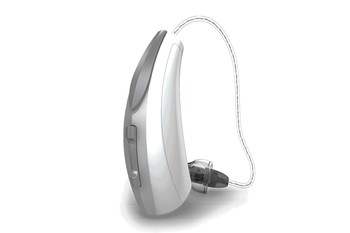 People with both hearing and vision loss benefit from a new AI-powered wearable device. The assistive technology combines Starkey's Livio Edge AI hearing aids with OrCam's wearable MyEye device. OrCam Technologies of Jerusalem is an artificial vision pioneer. Starkey is an American hearing industry leader. The two systems are integrated via a wireless connection.
People with both hearing and vision loss benefit from a new AI-powered wearable device. The assistive technology combines Starkey's Livio Edge AI hearing aids with OrCam's wearable MyEye device. OrCam Technologies of Jerusalem is an artificial vision pioneer. Starkey is an American hearing industry leader. The two systems are integrated via a wireless connection.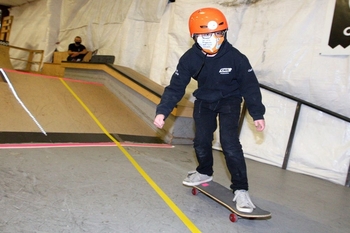 In Calgary, a skatepark was repurposed for blind and visually impaired skateboarders. Using high-contrast markings and audio cues, blind and visually impaired skaters could utilize The Compound skatepark in Ramsay. The team of visually impaired and blind skateboarders goes by the name the "Skate Bats."
In Calgary, a skatepark was repurposed for blind and visually impaired skateboarders. Using high-contrast markings and audio cues, blind and visually impaired skaters could utilize The Compound skatepark in Ramsay. The team of visually impaired and blind skateboarders goes by the name the "Skate Bats."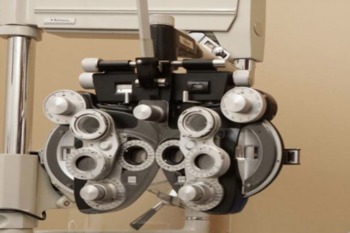 Dr. Michael Cusick, an ophthalmologist with the University of Virginia Health, is raising awareness about vision loss for people under 65. Dr. Cusick points out that many people have no symptoms of diabetic retinopathy until it's too late; it's the leading cause of vision loss for people under 65. Regular eye exams are crucial to spot leaking blood vessels in the back of the eye.
Dr. Michael Cusick, an ophthalmologist with the University of Virginia Health, is raising awareness about vision loss for people under 65. Dr. Cusick points out that many people have no symptoms of diabetic retinopathy until it's too late; it's the leading cause of vision loss for people under 65. Regular eye exams are crucial to spot leaking blood vessels in the back of the eye. Red-green color blindness or deuteranopia is an inability to distinguish red and green pigments. It is most likely a congenital condition that many people don't know they have unless it's pointed out. There are red-green color blindness indicators, including confusing red and green pigments. A difficulty spotting reds and greens or their variations (oranges and browns) is another indicator.
Red-green color blindness or deuteranopia is an inability to distinguish red and green pigments. It is most likely a congenital condition that many people don't know they have unless it's pointed out. There are red-green color blindness indicators, including confusing red and green pigments. A difficulty spotting reds and greens or their variations (oranges and browns) is another indicator. Age-related macular degeneration (AMD) is the leading cause of adult blindness, it slowly robs people of their vision. Over the years, companies have made claims that Vitamin D, omega-3 fatty acids, and other supplements may help with preventing macular degeneration or vision loss. However, new research suggests that neither vitamin D nor omega-3s reduced the number of AMD cases. The findings were published in JAMA Ophthalmology.
Age-related macular degeneration (AMD) is the leading cause of adult blindness, it slowly robs people of their vision. Over the years, companies have made claims that Vitamin D, omega-3 fatty acids, and other supplements may help with preventing macular degeneration or vision loss. However, new research suggests that neither vitamin D nor omega-3s reduced the number of AMD cases. The findings were published in JAMA Ophthalmology.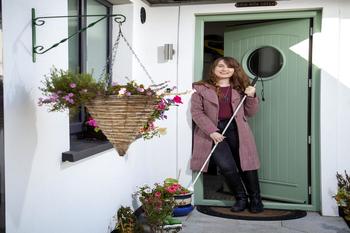 Maeve Doyle is living with a genetic condition that impacts her ability to see—Stargardt disease. Doyle, 18, started college this year; she is studying genetics and may one day find a treatment for her blinding eye disease. Stargardt disease causes progressive vision loss. She says:
Maeve Doyle is living with a genetic condition that impacts her ability to see—Stargardt disease. Doyle, 18, started college this year; she is studying genetics and may one day find a treatment for her blinding eye disease. Stargardt disease causes progressive vision loss. She says:
